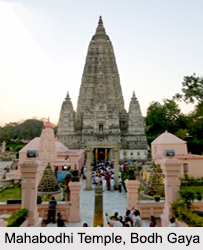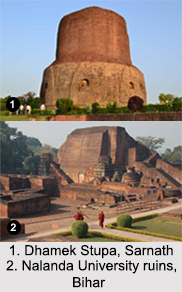 While the eastern Indian state of West Bengal possesses a rich heritage of colonial memorabilia, Odisha is famous for Hindu stone temples and Bihar is known for its Buddhist stupas and excavations.
While the eastern Indian state of West Bengal possesses a rich heritage of colonial memorabilia, Odisha is famous for Hindu stone temples and Bihar is known for its Buddhist stupas and excavations.
Konark Sun Temple, Odisha
The most notable architectural marvel of Odisha is the stately Sun Temple of Konark, established in 1255 AD during the reign of King Narasimhadeva I of Eastern Ganga Dynasty. The principal deity worshipped in the place is the Sun God (Surya or Arka). The entire complex of the temple is designed like a gigantic chariot of Surya, embellished with elaborate carvings of stone wheels, pillars and walls. A UNESCO World Heritage Site, its major chunk is presently in a state of ruins.
Mahabodhi Temple, Bodh Gaya
The renowned Mahabodhi Temple in Bodh Gaya, Bihar is a Buddhist Vihara marking the site where Gautama Buddha is believed to have attained enlightenment. It is listed in UNESCO World Heritage Sites as Mahabodhi Temple Complex at Bodh Gaya. The site contains a descendant of the Bodhi Tree under which Buddha meditated and is one of the oldest surviving brick structures in eastern India.
Udayagiri and Khandagiri Caves, Odisha
 Udayagiri and Khandagiri Caves are partly natural-partly artificial caves of archaeological and historical relevance, near Bhubaneswar in Odisha. The rock-cut shelters are situated on two adjacent hills Udayagiri and Khandagiri, mentioned as Kumari Parvat in the inscription in Hathi Gumpha (Elephant Cave), Cave No. 14 in Udayagiri. The range of finely carved caves date back to 2nd century BCE, most of them believed to have been carved out as residential blocks for Jain ascetics during the reign of King Kharavela. Udayagiri encompasses 18 caves, most prominent of them being Rani Gumpha which is a double-storeyed monastery, while Khandagiri has 15 caves.
Udayagiri and Khandagiri Caves are partly natural-partly artificial caves of archaeological and historical relevance, near Bhubaneswar in Odisha. The rock-cut shelters are situated on two adjacent hills Udayagiri and Khandagiri, mentioned as Kumari Parvat in the inscription in Hathi Gumpha (Elephant Cave), Cave No. 14 in Udayagiri. The range of finely carved caves date back to 2nd century BCE, most of them believed to have been carved out as residential blocks for Jain ascetics during the reign of King Kharavela. Udayagiri encompasses 18 caves, most prominent of them being Rani Gumpha which is a double-storeyed monastery, while Khandagiri has 15 caves.
Buddhist Sites at Sarnath
Sarnath in Uttar Pradesh is the place where Buddha delivered his first sermon after attaining enlightenment. The deer park in Sarnath is where Buddha first preached the Dharma and where the Buddhist Sangha came into existence through the enlightenment of Kondanna, a follower of Buddha. The most massive structure here is Dhamek Stupa, erected in 500 AD to replace an earlier structure commissioned by the great Mauryan king Ashoka, in 249 BCE. It stands high at 128 feet with 93 feet diameter. Chaukhandi Stupa is another important stupa that believably commemorates the spot where Buddha met his first disciples travelling from Bodh Gaya to Sarnath.
Nalanda University, Bihar
Nalanda in Bihar is where the ruins of an ancient monastic university that flourished from 5th to 11th century have been excavated. It is said to have contained 9 million books with 2,000 teachers to impart knowledge to 10,000 students from all over the Buddhist community.



















